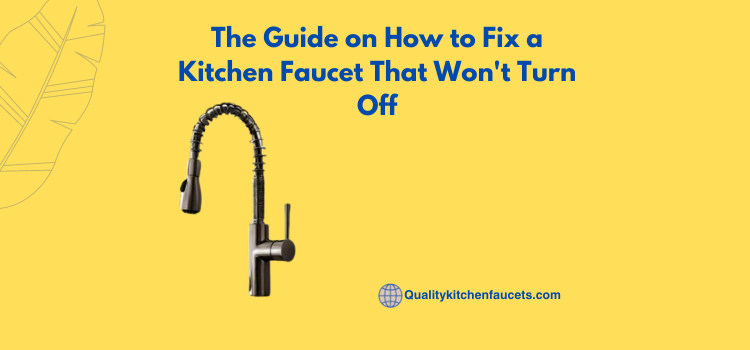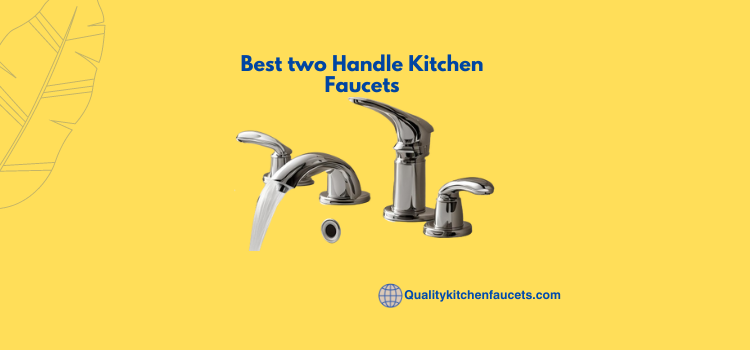The Guide on How to Fix a Kitchen Faucet That Won’t Turn Off
A common problem with the kitchen faucet is that the won’t turn off even if you turn it off. You are not the only one to face this issue.
It is annoying, but the good news is that it can be fixed in inexpensive ways. the answer to how to fix a kitchen faucet that won’t turn off is All you need to know some tools and tips
The reason could be the faulty valve. The valve controls water flow, and if it’s worn out or damaged, it can fail to stop the flow even when turned off. In this case, you’ll need to replace the valve or the entire faucet.
First, turn off your home’s main water supply to stop the water flow. If you’re unsure about performing this repair yourself, it’s advisable to hire a professional plumber

How to Fix a Kitchen Faucet that Won’t Turn Off
Problem 1: Your faucet’s handle is stripped
When you turn your handle, does it spin without ever settling into one position?
That’s a sign that your faucet’s handle is stripped. Handles are joined to stems with small threads that make it so you can turn your handle.
Over time, these threads may corrode and strip out, leaving your handle unable to control the water supply.
Solution:
In most cases, you’ll need to simply replace the handle. We usually recommend replacing both handles at once, so you don’t have to worry about the other one breaking down sooner. In some cases, you may need a new stem as well.
Because many handles are difficult to remove from your faucet (because they require a special wrench or they’ve corroded into the faucet), you should contact a plumber to remove the handle and inspect it for any stripped threads.
Problem 2: Your handle’s stem needs a new washer
Your faucet’s stem uses a washer to distribute pressure from the screw so it doesn’t loosen over time. However, if a stem hasn’t been lubricated, the washer can crack or tear, which means you handle can’t shut off the water.
Solution:
Contact a plumber to remove your handle and inspect your stem to make sure it’s lubricated and that it has a functioning washer

Problem 3: Your handle’s seat needs to be replaced
A faucet handle consists of a small part called a seat that helps your handle turn. Over time, your handle’s stems get wear and tear from regular use (think about how many times a day you turn on your faucet!).
Solution:
You’ll need to contact a plumber to replace, or at least sand smooth, your handle’s seat.
Identify Your Faucet
Before diving into the troubleshooting process for a kitchen faucet that won’t turn off, it’s crucial to correctly identify the type of faucet you have.
Not all faucets are built the same way, and understanding the specific design of your faucet will greatly aid in effectively addressing the issue. Different faucet types may have distinct mechanisms and components that could be causing the problem.
Here’s a simple guide to help you accurately identify your kitchen faucet:
- Compression Faucets:
- These faucets feature separate hot and cold handles that need to be turned multiple times to shut off the water flow. They are recognizable by their traditional design and the up-and-down motion required to control the water.
- Ball Faucets:
- Ball faucets are characterized by a single lever that moves in multiple directions to regulate both temperature and flow.
- The handle’s unique range of motion sets it apart from other faucet types.
- Cartridge Faucets: These faucets also use a single lever, but with a smoother and more controlled motion. Cartridge faucets are often identified by their sleek appearance and ease of use.
- Ceramic Disc Faucets:
- These modern faucets come with a single lever or two separate handles. They’re known for their durability and smooth operation.
- The distinct feature of ceramic disc faucets is the rotational movement of the handle(s).
Identifying your faucet correctly will help you narrow down the potential causes of the issue and find appropriate solutions.
Once you’ve pinpointed the type of faucet you have, you can proceed to troubleshoot and fix the problem of a kitchen faucet that won’t turn off. Remember, having a clear understanding of your faucet’s design is the first step towards a successful repair.








Informative Blog!
Hi there I am so excited I found your web site, I really found
you by accident, while I was looking on Google for
something else, Regardless I am here now and would just like to say thanks for a fantastic post and a all round interesting blog (I also love the
theme/design), I don’t have time to read through it all at the minute but I have book-marked it and
also added your RSS feeds, so when I have time I will be back to
read much more, Please do keep up the excellent job.